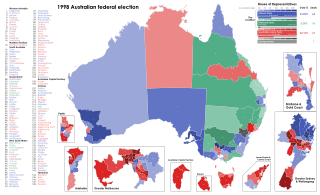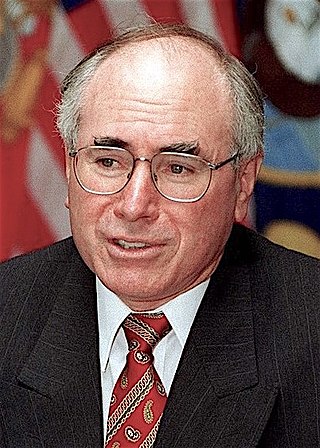
The Australian Democrats is a centrist political party in Australia. Founded in 1977 from a merger of the Australia Party and the New Liberal Movement, both of which were descended from Liberal Party dissenting splinter groups, it was Australia's largest minor party from its formation in 1977 through to 2004 and frequently held the balance of power in the Senate during that time.
The Australia Party was a minor political party established initially in 1966 as the Liberal Reform Group. As the Australia Party, it became influential, particularly in the landmark 1972 federal election when its preferences assisted the Australian Labor Party to victory—ending 23 years of Liberal/Country Coalition government.
This is a list of members of the Australian Senate from 1 July 2002 to 30 June 2005. Half of the state senators had been elected at the November 2001 election and had terms due to finish on 30 June 2008; the other half of the state senators had been elected at the October 1998 election and had terms due to finish on 30 June 2005. The territory senators were elected at the November 2001 election and their terms ended at the next federal election, which was October 2004.

The 1998 Australian federal election was held to determine the members of the 39th Parliament of Australia. It was held on 3 October 1998. All 148 seats of the House of Representatives and 40 seats of the 76-seat Senate were up for election. The incumbent centre-right Liberal/National Coalition government led by Prime Minister John Howard of the Liberal Party and coalition partner Tim Fischer of the National Party defeated the centre-left Australian Labor Party opposition led by Opposition Leader Kim Beazley, despite losing the nationwide popular and two-party preferred vote. However, the Australian Labor Party gained seats from the previous election.

The 1996 Australian federal election was held to determine the members of the 38th Parliament of Australia. It was held on 2 March 1996. All 148 seats of the House of Representatives and 40 seats of the 76-seat Senate were up for election. The centre-right Liberal/National Coalition led by Opposition Leader John Howard of the Liberal Party and coalition partner Tim Fischer of the National Party defeated the incumbent centre-left Australian Labor Party government led by Prime Minister Paul Keating in a landslide victory. The Coalition won 94 seats in the House of Representatives, which is the largest number of seats held by a federal government to date, and only the second time a party had won over 90 seats at a federal election.
Members of the New South Wales Legislative Council who served in the 54th Parliament were elected at the 2003 and 2007 elections. As members serve eight-year terms, half of the Council was elected in 2003 and did not face re-election in 2007, and the members elected in 2007 did not face re-election until 2011. The President was Meredith Burgmann.
This is a list of members of the Australian Senate from 1999 to 2002. Half of the state senators had been elected at the March 1996 election and had terms due to finish on 30 June 2002; the other half of the state senators were elected at the October 1998 election and had terms due to finish on 30 June 2005. The territory senators were elected at the October 1998 election and their terms ended at the next federal election, which was November 2001.
This is a list of members of the Western Australian Legislative Council between 22 May 2005 and 21 May 2009:
This is a list of members of the Australian Senate from 1996 to 1999. Half of the state senators had been elected at the March 1993 election and had terms due to finish on 30 June 1999; the other half of the state senators were elected at the March 1996 election and had terms due to finish on 30 June 2002. The territory senators were elected at the March 1996 election and their terms ended at the next federal election, which was October 1998.
This is a list of members of the Australian Senate from 1993 to 1996. Half of the state senators had been elected at the March 1990 election and had terms due to finish on 30 June 1996; the other half of the state senators were elected at the March 1993 election and had terms due to finish on 30 June 1999. The territory senators were elected at the March 1993 election and their terms ended at the next federal election, which was March 1996.

The Liberal National Party of Queensland (LNP) is a major political party in Queensland, Australia. It was formed in 2008 by a merger of the Queensland divisions of the Liberal Party and the National Party. At a federal level and in most other states, the two parties remain distinct and often operate as a Coalition. The LNP is a division of the Liberal Party of Australia, and an affiliate of the National Party of Australia.
Members of the New South Wales Legislative Council who served in the 51st Parliament were affected by the 1991 referendum. The Council consisted of 42 members, 6 elected in 1988, 15 elected in 1991 and 21 elected in 1995. As members serve eight-year terms, half of the Council did not face re-election in 1995, and the members elected in 1995 did not face re-election until 2003. The President was Max Willis until 29 June 1998 and then Virginia Chadwick.
Members of the New South Wales Legislative Council who served in the 48th Parliament were elected at the 1978, 1981 and 1984 elections. Members served for three terms of the Legislative Assembly, which, as a result of the 1981 referendum meant the maximum term was twelve years. The 15 members elected in 1978 did not face re-election until 1988, the 15 members elected in 1981 did not face re-election until 1992 and the 15 members elected in 1984 did not face re-election until 1996. The President was Johno Johnson.

The 1974 Australian federal election was held in Australia on 18 May 1974. All 127 seats in the House of Representatives and all 60 seats in the Senate were up for election, due to a double dissolution. The incumbent Labor Party led by Prime Minister Gough Whitlam defeated the opposition Liberal–Country coalition led by Billy Snedden. This marked the first time that a Labor leader won two consecutive elections.
Paul John Zammit is a former Australian politician. He was a member of the House of Representatives from 1996 to 1998, representing the seat of Lowe. He was elected as a member of the Liberal Party, but resigned from the party and unsuccessfully sought re-election as an independent at the 1998 federal election. He had previously been a Liberal member of the New South Wales Legislative Assembly from 1984 to 1996.
This is a list of the members of the Australian House of Representatives in the 17th Australian Parliament, which was elected at the 1943 election on 21 August 1943. The incumbent Australian Labor Party led by Prime Minister of Australia John Curtin defeated the opposition Country Party led by Arthur Fadden with coalition partner the United Australia Party (UAP) led by Billy Hughes. On 21 February 1945, the parliamentary UAP was dissolved and replaced by the newly established Liberal Party.
This is a list of members of the Australian Senate between 2011 and 2014. Half of the state senators had been elected at the November 2007 election and had terms due to finish on 30 June 2014; the other half of the state senators were elected at the August 2010 election and had terms due to finish on 30 June 2017. The territory senators were elected at the August 2010 election and their terms ended at the next federal election, which was September 2013. The new Senate first met in July 2011, with state senators elected in 2010 sworn in on 4 July 2011.
This is a list of members of the Australian House of Representatives of the 44th Parliament of Australia (2013–2016), as elected at the 2013 federal election.
This is a list of members of the Australian Senate between July 2014 and May 2016. Half of the state senators had been elected at the August 2010 election and had terms due to finish on 30 June 2017; the other half of the state senators were elected at the September 2013 election and had terms due to finish on 30 June 2020. The territory senators were elected at the September 2013 election and their terms ended at the dissolution of the House of Representatives, which was May 2016. The new Senate first met in July 2014, with state senators elected in 2013 sworn in on 7 July 2014. Ascertaining the chamber's final composition was complicated by the loss of 1,375 ballot papers in Western Australia, leading to the Court of Disputed Returns voiding the result there, and necessitating a special Senate election in Western Australia.

This is a list of members of the Australian Senate following the 2016 Australian federal election held on 2 July 2016. The election was held as a consequence of a double dissolution in which both houses of parliament were dissolved. Ordinarily, only half of the senators terms end at each election. In this case, all 76 senators were elected. At the first sitting following the election, half of the senators representing each of the six states of Australia were allocated six-year terms to end on 30 June 2022, with the remainder allocated three-year terms to end on 30 June 2019. The terms of senators from the Australian Capital Territory and the Northern Territory end on the day of the next federal election.







